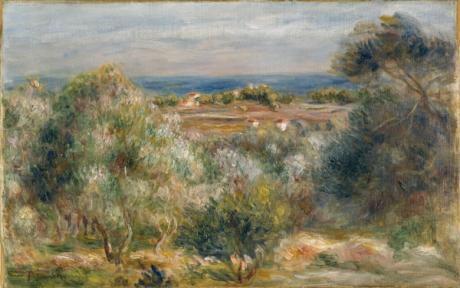
The city of Hagen in northern Germany returned a landscape by Auguste Renoir to the heirs of a Jewish banker persecuted by the Nazis and bought it back from them so the painting could remain in the Osthaus museum, where it is exhibited since 1989.
The redemption of the 1910 painting, View of the sea from Haut Cagnes, was financed by the Land of North Rhine-Westphalia, the German Ministry of Culture and the Cultural Foundation of the States. The city of Hagen said in a press release that the painting will in future be displayed with information about its former owner, Jakob Goldschmidt, who was forced to flee Nazi Germany.
“The heirs of Jakob Goldschmidt are pleased to have reached an agreement satisfactory to both parties in this matter after more than 15 years of intensive discussions,” their attorney, Sabine Rudolph, said in a statement. “The return of the painting is an acknowledgment that their grandfather suffered great wrongs under the Nazi regime, including enormous financial loss.”
Goldschmidt was one of Weimar Germany’s most influential bankers. He began collecting Impressionist and Old Master art in the 1920s and was also a major patron of the Neue Nationalgalerie in Berlin. He fled to Switzerland in 1933, then emigrated to the United States, where he died in 1955.
Part of his art collection remained in Berlin as collateral for a loan. The Nazis seized it, including Renoir’s painting of the Côte d’Azur, in 1941. The work was sold that year at the Berlin auction house Hans W. Lange. It was again offered for sale at the Galerie Nathan in Zurich in 1960, then bought by the first president of the BDI association of German industry, Fritz Berg. After his widow’s death, Berg’s collection went to the Osthaus Museum in Hagen.
In another similar settlement, Germany’s Akademie der Künste said it returned a sketchbook containing drawings of garden cafes in Berlin by Max Liebermann to the artists’ heirs and bought it back for safekeeping in its collection. The Akademie der Künste bought the sketchbook in 2005 at an auction house in Munich. Liebermann, who was Jewish, was the president of the AdK’s precursor, the Prussian Academy of Arts, but he was forced to leave the association in 1933 after the Nazis seized power.
After his death in 1935, Liebermann’s widow affixed to all his unsigned works a facsimile of his signature. The sketchbook contained the stamp, proof that it was in his possession until at least 1935. Martha Liebermann’s considerable assets were confiscated by the Nazis. She committed suicide in 1943 to avoid deportation to Theresienstadt concentration camp. After his death, the Gestapo seized the contents of his apartment: their inventory of his possessions included “three sketchbooks”.
“It is not known whether this sketchbook was still in his possession at that time,” the Akademie der Künste said in a statement. “However, we can assume that Martha Liebermann had to give it up between 1935 and 1943 under the pressure of Nazi persecution.”
